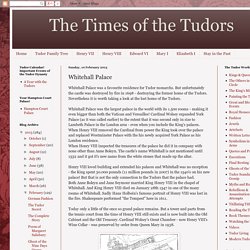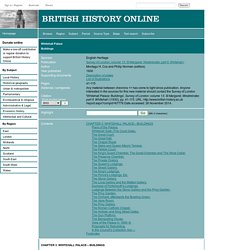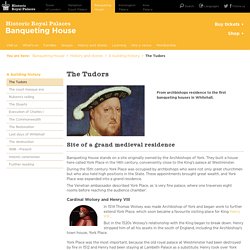

York Place. Whitehall Palace Garden. The Times of the Tudors: Whitehall Palace. Whitehall Palace was a favourite residence for Tudor monarchs.

But unfortunately the castle was destroyed by fire in 1698 - destroying the former home of the Tudors. Nevertheless it is worth taking a look at the lost home of the Tudors. Whitehall Palace was the largest palace in the world with its 1.500 rooms - making it even bigger than both the Vatican and Versailles! Cardinal Wolsey expanded York Palace (as it was called earlier) to the extent that it was second only in size to Lambeth Palace in the London area - even when you include the King's palaces. Whitehall Palace - The Tudors Wiki. Whitehall and Anne Boleyn. Is the metonymy “Whitehall” part of Anne Boleyn’s legacy?

By Annis Castellina, Whitehall Palace Tour Guide Largely vanished now, Whitehall Palace, in the heart of London, was the largest and, in the age of Elizabeth 1st, the most dazzling Renaissance Court of Europe. Some of its foundations and fireplaces, still remain under the road. From these, from contemporary plans, descriptions and paintings, archeologists and historians of the Royal Palaces can now reconstruct it. Queen Elizabeth 1st walked in its formal gardens in impressive dresses, danced La Volta here in the Presence Chamber or Great Chamber, watched plays at Twelfth Night, held elaborate court ceremonies in the Privy Garden, and received shields from her nobles at Whitehall.
At Whitehall Palace, the Court and its support staff, lodged in over a thousand rooms, heated by fireplaces and blue ceramic stoves using sea-coal. Home of Tudor and Stuart Monarchs Henry VIII had sixty palaces, castles or fortified manor houses. Survey of London: volume 13 (pp. 41-115) Sorbière came to England about 1665, and has left his impressions on record.

Whitehall Palace. Palace of Whitehall. Coordinates: Inigo Jones's plan, dated 1638, for a new palace at Whitehall.

London’s lost Whitehall Palace deserves to be properly commemorated. Ask anyone who knows London what they understand by the term Whitehall and, more likely than not, they’ll tell you it’s the seat of the British government.

And they wouldn’t be wrong – through just a short walk you can take in Downing Street, the Ministry of Defence, Foreign Office and other important ministries. But while all this is correct, it is a narrow view of Whitehall which only takes into account the district’s history over the last few centuries. Quite simply, there is so much more to discover about this fascinating area. Whitehall was the site of a grand palace which was in Royal hands from Tudor times. Henry VIII seized what was York Place from Cardinal Wolsey in 1530 when he fell out of favour with the king and embarked on an enormous building project, transforming it to the most magnificent palace in Britain. Today all that remains of Whitehall Palace is the Banqueting House which was commissioned by James I in 1619.
Like this: Like Loading... Survey of London: volume 13 (pp. 10-40) The King did not wait for the completion of the legal formalities before taking possession of York Place.

On 2nd November, 1529, only a few days after Wolsey's departure, he came from Greenwich by water, "and landed at the house which once belonged to the Cardinal, where he has found handsome and well-furnished apartments, provided with everything that could be wished. " (fn. 1) In the Privy Purse Expenses of Henry VIII (fn. 2) are several items relating to York Place from November, 1529, to January, 1529–30, such as: (fn. 3) Henry VIII. Among the same expenses are two items of payment to Doctor Stubbs (i) in November, 1529, of £200 "for his bylding at yorke place," and (ii) on 1st April, 1530, of £400 "to be employed aboute the Kinges buyeldinges at yorke place. " Lawrence Stubbs was Wolsey's almoner (fn. 4) and acted as his surveyor.
It appears therefore that the works referred to in the privy purse expenses were in continuation of those set on foot by Wolsey. (iii) & (iv). Survey of London: volume 13 (pp. 3-9) Learn About The Banqueting Houses At Whitehall in Tudor Times. Banqueting House stands on a site originally owned by the Archbishops of York.

They built a house here called York Place in the 14th century, conveniently close to the King's palace at Westminster. During the 15th century York Place was occupied by archbishops who were not only great churchmen but who also held high positions in the State. These appointments brought great wealth, and York Place was expanded into a grand residence. The Venetian ambassador described York Place, as 'a very fine palace, where one traverses eight rooms before reaching the audience chamber'. Cardinal Wolsey and Henry VIII In 1514 Thomas Wolsey was made Archbishop of York and began work to further extend York Place, which soon became a favourite visiting place for King Henry VIII .
But in the 1520s Wolsey's relationship with the King began to break down. Henry’s pleasure buildings Henry VIII acquired a large plot of land opposite his new palace.